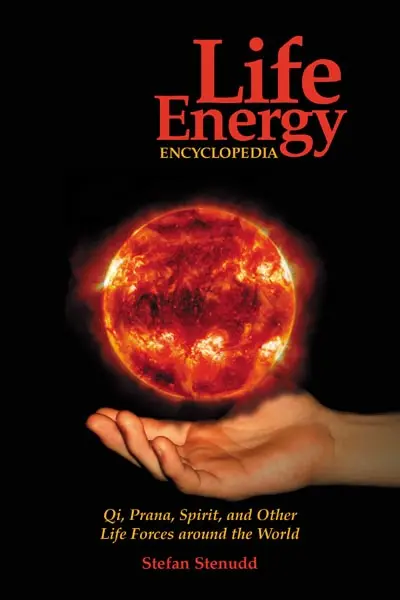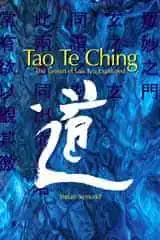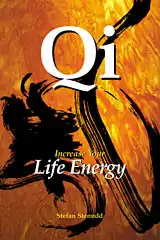The Book

Life Energy Encyclopedia
by Stefan Stenudd
In every part of the world, already thousands of years ago, humans have speculated about some kind of life force. There are hundreds of life energy beliefs, ancient and contemporary. In this book I present and explain just about all of them.
In China it's called qi (also spelled chi or ch'i), in India prana, in ancient Greece pneuma, in Latin Spiritus, in Hebrew ruach, and in European metaphysical traditions it's called vitalism.
Click here to see the book at Amazon (paid link).
Different Life Forces
I've been interested in life force ideas since my youth, and not just through my aikido practice, although that's a martial art impregnated by life energy applications. But it did, through our knowledgeable Japanese instructor Toshikazu Ichimura, give me some insights into the complexity of it all. Ichimura was also the first one to point out to me that similar life energy ideas existed in many cultures.
Many years later I wanted to explore this phenomenon from the perspective of the history of ideas. I was researching the thought patterns behind creation myths and found several similar concepts appearing in many of them, regardless of their origin. The life force, the idea of some kind of essence separating the living from the dead, is certainly one of them. So, I decided to investigate it as an example of key ingredients in ancient belief systems.
I was definitely not the first to do so. In the literature, the similarity between life force concepts has often been pointed out. But I had not seen a study examining and comparing them at depth. Instead, most of the texts made general remarks in passing, stating that there are so and so many similar or even identical life force concepts around the world.
Such claims need to be tested. In my study of creation myths I have found that apparent similarities are not that similar at all, upon close inspection. The same might be true for life energy beliefs. So, I started what can be described as sort of an inventory.
It was not an easy task. I went through all my books touching on the subject and I spent countless hours surfing the Internet. The Lund University library, one of the oldest and biggest in Sweden, was also searched. It took a few years.
What I found was what I had suspected. True, there are numerous life force beliefs and theories in the world, and some of them are alike — but far from all. There are more differences than similarities. Still, the questions they try to answer are sort of the same, and they deal with the core of what life is and what the world seems to be.
Inventory and Theory
I presented my research and conclusions on a seminar at the Lund University. But that was quite a closed set, so it would be a waste not to make my material accessible to others who might be interested in the subject. At least, it would save them hundreds of hours searching for the material themselves. I had to make a book.
So here it is. My inventory of life force concepts is presented in the form of an encyclopedia. I know it's a big word for a book that doesn't even reach 200 pages, but it would be more misleading to call it a dictionary.
The title is also chosen to confirm that I took on the task of verifying all the facts, which was quite an ordeal. A lot of the material is by definition vague and untouched by academic scrutiny. That's particularly true for life force concepts of the last couple of centuries, but traditional and ancient concepts are also clouded by misconceptions repeated just as often as the correct facts. In some cases, there is no way of asserting what the facts are.
In addition to the encyclopedia of life force concepts, I wrote an introduction examining the broad picture and speculating about the sources and inspirations to thoughts about a life force. Also, there are patterns showing how these concepts adapt to the world view of the time and the cultural setting in which they appear. The last few centuries have shown this with increasing clarity. Life force beliefs develop through time and adapt to what science discovers.
I hope that my book will be rewarding, maybe even enlightening, to anyone interested in the idea of a life force or life energy. At least I'm sure that every reader will save countless hours of searching the libraries and the web.
How to get the book
If you want to buy the book, you can do so at most Internet bookstores. Click the image below to see the book at Amazon (paid link). The link takes you to your local Amazon store (or to Amazon.com).


Click the header to visit the book's Facebook page.
The Contents
Here is the book's Table of Contents:
Foreword 7
Introduction 11
Homo rudis 11
Life and death 14
The mover 15
Prime mover 17
Air 19
Bodily fluids 22
Survival 25
The dead 29
Spirits 31
Hell 33
Change 39
Agricultual order 41
A demanding spirit 44
Magic 46
The Scientific Revolution 51
Mechanical man 54
Subversive spirits 55
Alien forces 59
Future speculations 63
Encyclopedia 67-194
Samples
Here are two extracts from the book, as Acrobat PDF files in computer screen resolution (72 DPI):
From the introduction
From the encyclopedia
About me
I'm a Swedish author and historian of ideas, mainly researching the thought patterns of myth in general and creation myths in particular. I'm also an instructor of the peaceful and spiritual martial art aikido, which I have practiced since 1972. Aikido, too, evolved from ideas of a life energy.
Foreword of the Book
Since childhood, I have been addicted to inspiration. It is one of those things that make life worth living. Contrary to many reports of the opposite, I have always found inspiration easy to induce, for example by listening to music, looking at master paintings, or reading a really good novel — but mostly by simply rolling up my sleeves and getting to work on something that demands inspiration, again usually something artistic.
When inspiration flows, it feels as tangible within my body as a liquid, like the blood pumping through my veins, or an ether, like the air I inhale and exhale. Although inspiration is a state of mind, it feels no less real than my body and the world that surrounds me.
As a child, I observed the world through this ether of inspiration, and took delight in it.
As an adolescent, I happened to come across the peaceful martial art aikido (see the image), and started to practice it passionately. Thereby, I was introduced to ki, the Eastern idea of a life force (from Chinese usually transcribed qi or chi). It felt like inspiration, too, but with an expression of power. Ki was more for physical action, such as throwing fellow aikido practitioners around. The energy by which to get things done. An ether, just like inspiration, but one of intention. Still, they felt essentially the same.
I continued with aikido, and with some artistic expressions. Well, aikido is also an art. Let's call everything that inspires us art.
During my adult years, I have also studied the history of ideas — those of art, science, religion, philosophy, politics, and so on. What continues to fascinate me is to discover again and again the marvel of the human mind — already at times so ancient that we know precious little about them. Long before the very first book was written, clever minds had pondered the world and how it might work, and they came up with some brilliant explanations, impressive even when later proven wrong.
Wisdom is not dependent on truth. The latter is so much a question of perspective and interpretation, whereas the former is evident to all, through time and any change of civilization. The history of mankind is generous with examples of such wisdom.
And the wise have always speculated about the essence of life. What is it to be alive, and what makes it worthwhile? It can be of no surprise that some of the most inspired thoughts have dealt with the subject of inspiration, and with bewildering enigmas of that kind.
Well, the subject has definitely been treated with some striking folly, as well. Genius and folly are each other's prerequisite. The one cannot exist without the other. You have to dare to be a fool for your thoughts to go beyond the already known. Any great discovery begins as an absurdity, and every revelation is born in confusion. As for the arts, their realm is lunacy and every artist is obsessed.
Life is a mystery that might only be grasped through folly, speculation, inspiration, and intuition. Its very nature is not a thing to understand as much as to experience. This Life Energy Encyclopedia contains a number of speculations — sometimes foolish, often inspired — based on human experience. Whether right or wrong, they say a lot about the nature of this experience.
As long as there are new experiences made, there will be new speculations. That's the only truth.
Stefan Stenudd
Life Energy Encyclopedia
Qi, Prana, Spirit, and Other Life Forces around the World
by Stefan Stenudd, Arriba 2009
Paperback, 196 pages
ISBN: 978-91-7894-019-6
|
My Life Energy Books
Qi, prana, spirit, ruach, pneuma, and many other life forces around the world explained and compared. Click the image to see the book at Amazon (paid link).
The life energy qi (also chi or ki) explained, with several very easy exercises to awaken, increase, and use it. Click the image to see the book at Amazon (paid link).
|
My Other Websites
The ancient Chinese life energy
qi (
chi) explained and how to exercise it.
Creation stories from around the world, and the ancient cosmology they reveal.
What the Greek philosophers believed about the cosmos, their religion and their gods.
Taoism, the ancient Chinese philosophy of life explained. Also, the complete Tao Te Ching online.
Other Books of Mine
The Greek philosophers and what they thought about cosmology, myth, and the gods.
Click the image to see the book at Amazon (paid link).
This book examines Jungian theories on myth and religion, from Carl G. Jung to Jordan B. Peterson.
Click the image to see the book at Amazon (paid link).
The Taoism of Lao Tzu Explained. The great Taoist classic, translated and extensively commented chapter by chapter.
Click the image to see the book at Amazon (paid link).
Erroneous Tao Te Ching Citations Examined. 90 of the most spread false Lao Tzu quotes, why they are false and where they are really from.
Click the image to see the book at Amazon (paid link).
About me
I'm a Swedish author and historian of ideas, researching the thought patterns in creation myths. I've also written books about Taoism, the Tarot, and life force concepts around the world.
Click the image to get to my personal website.

 Cosmos of the Ancients
Cosmos of the Ancients Archetypes of Mythology
Archetypes of Mythology Tao Te Ching
Tao Te Ching Fake Lao Tzu Quotes
Fake Lao Tzu Quotes Stefan Stenudd
Stefan Stenudd

 Qi — Increase your life energy
Qi — Increase your life energy